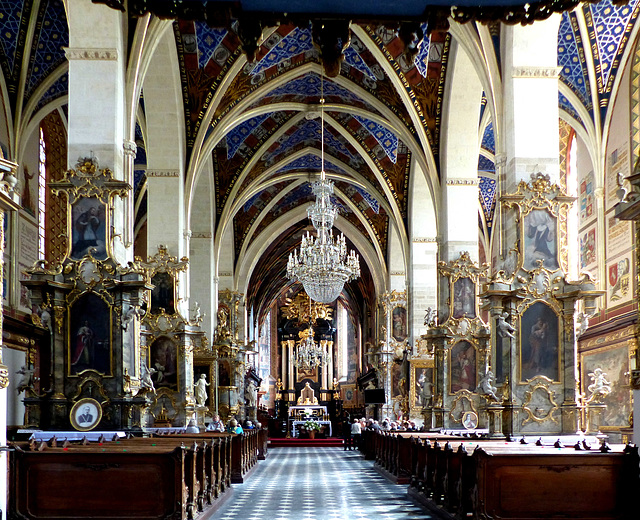Location
Lat, Lng: 50.676792, 21.749445
You can copy the above to your favourite mapping app.
Address: ulica Katedralna 2, 27-600, Sandomierz Lewobrzeżny, Sandomierz, Sandomierski, Świętokrzyskie
You can copy the above to your favourite mapping app.
Address: ulica Katedralna 2, 27-600, Sandomierz Lewobrzeżny, Sandomierz, Sandomierski, Świętokrzyskie
Keywords
Authorizations, license
-
Visible by: Everyone -
All rights reserved
-
87 visits
Sandomierz - Katedralna Narodzenia Najwietsej Marii Panny


Sandomierz was one of the most important cities in the Polish section of the Via Regia, taking advantage of the location at the junction of the Vistula and San rivers. The first known historical mention of the city comes from the early 12th-century when it was already ranked as one of the main cities of Poland. The testament of Bolesław III Wrymouth, in which he divided Poland among his sons, designated Sandomierz as the capital of one of the resulting principalities, the Duchy of Sandomierz.
In the early 13th century, the second oldest Dominican monastery in Poland was founded in Sandomierz. Within the 13th century, the city suffered grievous damage during the raids by Mongols in 1241, 1260, and 1287. The wooden buildings of the town were completely destroyed. As a result, in 1286 Leszek II the Black, effectively refounded the city.
After the reunification of the Polish lands in the 14th century, the former principality became the Sandomierz Voivodeship, incorporating large areas of southeastern Poland. In the middle of the 14th century, the city was burned again during a raid by the Lithuanians. It was rebuilt during the rule of Casimir III of Poland, who extended its privileges. The layout of the city has survived practically unchanged from that time until the present day.
Sandomierz prospered until the middle of the 17th century, but the prosperity came to an end in 1655 when Swedish troops captured the city. After briefly holding out in the city, the withdrawing Swedes blew up the castle and caused heavy damage to other buildings. A great fire in 1757 and the First Partition of Poland in 1772, which placed Sandomierz in Austria, further reduced its status.
In 1809, during the Napoleonic Wars, fighting between the forces of Austria and the Duchy of Warsaw caused damage to the city. It became part of the short-lived Polish Duchy of Warsaw and after 1815 it found itself in the Russian Empire ("Congress Poland").
-
The predecessor of today's Cathedral of the Nativity of the Blessed Virgin Mary was a Romanesque church was built above the Vistula River, first mentioned in 1148. It was destroyed by the Tatars in the 13th century and finally by the Lithuanians in 1349.
In 1360 Casimir III ("the Great") donated a new three-nave Gothic collegiate church. The church was consecrated in 1382. During the retreat of the Swedes in 1656, the roof truss of the church caught fire.
The church received a baroque facade from 1670 to 1674 and during the 18th century, the interior was also remodeled in the baroque style. With the creation of the Diocese of Sandomierz in 1818, it was elevated to the status of a cathedral.
Translate into English
In the early 13th century, the second oldest Dominican monastery in Poland was founded in Sandomierz. Within the 13th century, the city suffered grievous damage during the raids by Mongols in 1241, 1260, and 1287. The wooden buildings of the town were completely destroyed. As a result, in 1286 Leszek II the Black, effectively refounded the city.
After the reunification of the Polish lands in the 14th century, the former principality became the Sandomierz Voivodeship, incorporating large areas of southeastern Poland. In the middle of the 14th century, the city was burned again during a raid by the Lithuanians. It was rebuilt during the rule of Casimir III of Poland, who extended its privileges. The layout of the city has survived practically unchanged from that time until the present day.
Sandomierz prospered until the middle of the 17th century, but the prosperity came to an end in 1655 when Swedish troops captured the city. After briefly holding out in the city, the withdrawing Swedes blew up the castle and caused heavy damage to other buildings. A great fire in 1757 and the First Partition of Poland in 1772, which placed Sandomierz in Austria, further reduced its status.
In 1809, during the Napoleonic Wars, fighting between the forces of Austria and the Duchy of Warsaw caused damage to the city. It became part of the short-lived Polish Duchy of Warsaw and after 1815 it found itself in the Russian Empire ("Congress Poland").
-
The predecessor of today's Cathedral of the Nativity of the Blessed Virgin Mary was a Romanesque church was built above the Vistula River, first mentioned in 1148. It was destroyed by the Tatars in the 13th century and finally by the Lithuanians in 1349.
In 1360 Casimir III ("the Great") donated a new three-nave Gothic collegiate church. The church was consecrated in 1382. During the retreat of the Swedes in 1656, the roof truss of the church caught fire.
The church received a baroque facade from 1670 to 1674 and during the 18th century, the interior was also remodeled in the baroque style. With the creation of the Diocese of Sandomierz in 1818, it was elevated to the status of a cathedral.
Marco F. Delminho, kiiti, Ulrich John have particularly liked this photo
- Keyboard shortcuts:
Jump to top
RSS feed- Latest comments - Subscribe to the comment feeds of this photo
- ipernity © 2007-2025
- Help & Contact
|
Club news
|
About ipernity
|
History |
ipernity Club & Prices |
Guide of good conduct
Donate | Group guidelines | Privacy policy | Terms of use | Statutes | In memoria -
Facebook
Twitter











Sign-in to write a comment.